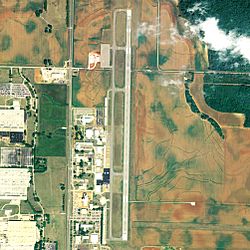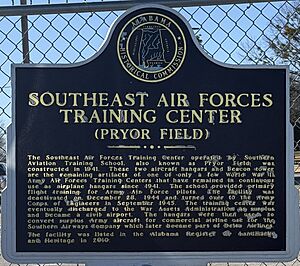Pryor Field Regional Airport facts for kids
Quick facts for kids
Pryor Field Regional Airport
|
|||||||||||
|---|---|---|---|---|---|---|---|---|---|---|---|

2006 USGS airphoto
|
|||||||||||
| Summary | |||||||||||
| Airport type | Public | ||||||||||
| Owner | Pryor Field Airport Authority | ||||||||||
| Serves | Decatur, Alabama | ||||||||||
| Location | Limestone County, Alabama | ||||||||||
| Elevation AMSL | 592 ft / 180 m | ||||||||||
| Coordinates | 34°39′15″N 86°56′43″W / 34.65417°N 86.94528°W | ||||||||||
| Map | |||||||||||
| Runway | |||||||||||
|
|||||||||||
| Statistics (2017) | |||||||||||
|
|||||||||||
|
Source: Federal Aviation Administration
|
|||||||||||
Pryor Field Regional Airport (IATA: DCU, ICAO: KDCU, FAA LID: DCU) is a busy public airport in Limestone County, Alabama. It's located a few miles from both Decatur and Athens. The airport is named after Schyler Pryor, an aviation instructor who sadly passed away in an airplane accident in 1944.
This airport is very important for the western part of the Huntsville-Decatur Combined Statistical Area. It's also the busiest regional airport in Alabama! Right next to the airport is Calhoun Community College, which helps make it a hub for learning and travel.
Contents
Airport Features and Airplanes
Pryor Field Regional Airport covers a large area of about 200 acres (81 hectares). It has one main runway, which is like a long, paved road for planes to take off and land. This runway is made of asphalt and is about 6,107 feet (1,861 meters) long and 100 feet (30 meters) wide.
Many airplanes use this airport. In 2006, there were over 167,000 airplane takeoffs and landings! Most of these were by private planes, but military aircraft and air taxis also use the field. The airport is home to many different types of planes, including single-engine planes, multi-engine planes, jets, helicopters, and even gliders.
A Look Back at Pryor Field's History
Pryor Field Regional Airport first opened in October 1941. Back then, it had a big square grass runway. It played a big role during World War II, training pilots for the United States Army Air Corps. Young pilots learned to fly planes like the Fairchild PT-19 and PT-17 Stearman here.
The training school also used five smaller airfields nearby for extra practice and emergency landings. After the war ended in 1944, the airport stopped training military pilots. It then became a public airport for everyone to use.
Growing the Airport
In the years after the war, local cities and counties worked together to make Pryor Field better. They helped get hangars and land so the airport could keep running. In 1958, the airport received money to build a new taxi strip, which is a path for planes to move between the runway and hangars. They also added better lights and fences.
By 1959, construction started to add more facilities. This was because the airport hoped to have commercial airlines flying there soon. They built new restrooms and planned for a waiting room and ticket office for passengers. The runway was long enough for planes like the Douglas DC-3, but bigger planes would need a longer runway.
Modern Upgrades and Expansion
Throughout the 1960s, Pryor Field continued to grow. The main runway was made 1,000 feet longer to handle bigger and faster airplanes. They also improved taxiways, lighting, and drainage. These changes helped the airport support more military and civilian flights, making it an important hub in northern Alabama.
In 2008, a brand new $1.8 million terminal building opened. This was part of a larger project that also made the runway even longer, reaching 6,000 feet (1,829 meters). This helped larger jets land safely. In January 2010, the old pilot training site was recognized as a historic landmark.
Recent Developments and Future Plans
Pryor Field continues to be a busy and growing airport. In January 2022, Adam Fox became the new airport manager. He has a lot of experience in aviation.
In April 2023, a company called Acquisition Integration (AI) agreed to a big plan to build maintenance and repair facilities at the airport. This $30 million project will create 170,000 square feet of new buildings and bring about 250 new jobs to the area.
In October 2023, the airport started a $2.6 million project to expand its taxiways and add more space for cargo planes. This will help the airport handle even more flights in the future.
Looking ahead, Calhoun Community College plans to open an Aviation Mechanic Program in the fall of 2024. This program will train students to work on airplanes, which is great news for the airport and the community. In February 2025, FTair, a company that fixes and maintains airplanes, also announced they would be opening a new service center at Pryor Field. This partnership will help the airport offer even more support for planes.
Airplane Incidents and Safety
Airports are very safe places, but sometimes accidents happen. Here are a few incidents that have occurred at Pryor Field over the years:
- On June 29, 1950, a U.S. Air Force C-119 "Flying Boxcar" had engine trouble and made an emergency landing in a cornfield near the airport. All five crew members survived, though two were injured.
- On April 24, 1955, a pilot named Charlie Rogers had a minor accident while landing in strong winds. His plane was damaged, but he was not hurt.
- On December 29, 1978, a tragic accident occurred when a man walked into a spinning propeller of a small plane. He was fatally injured.
- On May 30, 1983, a Cessna 310 plane crashed shortly after takeoff due to suspected engine problems. All five people on board survived, but some had injuries.
- On October 2, 1995, a student pilot lost control of a plane during a landing attempt. The plane was damaged, but the pilot was uninjured.
- On November 24, 1996, a U.S. Army helicopter crashed in a cotton field after a training mission. The two pilots had injuries but survived.
- On February 1, 1997, a Cessna 150 plane crashed near Decatur, killing both people on board. The investigation showed the plane stalled during a steep climb.
- On August 6, 2005, a Beech BE-D35 plane crashed shortly after takeoff, resulting in one death and one serious injury. The investigation found the pilot had not managed the fuel correctly.
- On April 6, 2007, a Beech D50E plane had both engines fail because the pilot ran out of fuel. The pilot made an emergency landing in a field, and all four people on board were unharmed.
- On July 17, 2007, a man was injured when he was struck by a wooden propeller while trying to start his plane by hand. He recovered after receiving stitches.
- On July 10, 2008, a small amphibious plane crashed into the Tennessee River, sadly killing the student pilot and instructor.
- On May 23, 2009, two experimental planes collided in the air during an open house event at Pryor Field. One pilot died, while the other plane landed safely. The accident was caused by one pilot not keeping enough distance from the other plane.
- On November 2, 2022, a Piper PA-28 plane ran out of fuel and had to make an emergency landing in a field. The plane was damaged, but the pilot was not hurt.
See also
- Alabama World War II Army Airfields
- List of airports in Alabama
- 29th Flying Training Wing (World War II)




